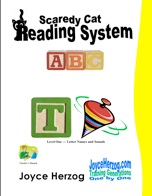This phonics-based reading and spelling program was written by a teacher with much experience teaching children with learning disabilities. The students are taught that vowels can be brave (long) or scared (short); hence the name Scaredy Cat Reading System. Joyce Herzog has designed a user-friendly method that should appeal to both child and parent.
Recognizing problems some children have with letter/sound identification, she has created "stories" to help children learn and remember. These stories originate from a comic that comes with the program: The Story of LetterMaster Who Gave the Vowels Their Jobs. Within the story is the rationale used in the system to teach letters and sounds; the behavior of the letters creates the inconsistencies of English letter/sound correspondence. (The comic is the introduction and will probably only be needed at the beginning of the program.) Like Alphabet Island, Scaredy Cat presents the concepts within the context of a story. For some learners, this device might be cumbersome while for others it will be very helpful.
There are three levels to the Scaredy Cat Reading System. Each level includes a teacher manual, student activity book, letter cards, an audio CD, and game boards. In addition, level one includes magnetic letters and pictures, The Story of LetterMaster, and ABC Reader. Level two adds a reader, magnetic letters and pictures, and more game boards. Level three adds a reader, a second audio CD, and lots more word cards.
The teacher manuals present many different learning activities from which you might choose. Level one relies more on the teacher’s direction than do the next two levels. The CDs feature audio presentations of the lessons that students might listen to on their own—a reading of The Story of LetterMaster on level one’s CD and readings of the actual lessons for the other two levels. Still, this is not an independent study program; it requires frequent interaction between student and teacher. The script for the audio lessons is printed in the teacher manuals. Student activity books include lesson practice, puzzles, handwriting practice, and coverage of spelling and other language arts skills (in levels two and three).
Level 1 covers the alphabet, beginning sounds, and an introduction to the vowels using many different activities. The CD includes songs that reinforce concepts. The teachers manual describes many hands-on activities using the magnetic letters, magnetic alphabet pictures, flashcards, and games that come with the set as well as many other activities to be done with resources found in most homes. This level includes “reversal posters” for extra work on those easily confused letters d/b, p/ q, N/Z, etc.
Level 2 teaches about "Scared Vowels" in three-letter consonant-vowel-consonant (CVC) words. Lessons are presented on audio CD with accompanying script. Cards, magnetic letters, and game boards provide a variety of learning experiences. Students who have had previous reading instruction but have progressed poorly can move through the materials quickly as they demonstrate mastery. Some students who have already learned the alphabet and beginning sounds might be ready to begin at this level. (Placement tests are available on the publisher’s website.)
Level 3 reviews CVC words and introduces new phonics rules such as "Brave Vowels," "R Bully," "Rebel Words," "Great Pretender Y," and others, again with scripted lessons presented on CD (but with two CD’s for this level). Upon completion, concepts through a second-grade reading and spelling level have been mastered.
Scared Cat Express (which was previously considered as level four) covers all phonics concepts from the CVC pattern through prefixes, suffixes, and foreign words and sounds. This level is designed for use by a teacher who is confident in her ability to teach reading and spelling and is only looking for the basics OR as a review level for older students needing help in reading or spelling. Students with learning disabilities might need to use both levels 3 and Express, while the average older student can probably jump straight to Express.
Variety is the hallmark of Scaredy Cat. Herzog has included games, lots of reading material, and many activity suggestions. The wealth of ideas reflects her years of practical experience and also makes it easier for us to adapt the program to suit the needs of different learners. We can do more auditory (listening to the CDs), visual (working with written materials in the book), or kinesthetic (hands-on) activities depending upon the need. Except for the student activity book, the materials are non-consumable and can be used to teach more than one child at a time.
The presentation of phonetic rules is a little unusual. The primary emphasis at first is on vowels since they present the most difficulties. The first rule about vowels has a number of exceptions that are covered in more depth elsewhere in the program. The book makes us conscious of the exceptions so we can acknowledge them if our child spots them.
Christian supplements are available. Bible Quotes for Phonics and Spelling can be used for reading, copywork, and handwriting practice after Rule One has been taught. SCRS Character Songs CD features 15 songs for the 15 Scaredy Cat rules. Each rule connect to biblical concepts.
While rule-oriented phonics programs with significantly more than Scaredy Cat’s fifteen rules appeal to some teachers and learners, many others will prefer Scaredy Cat's simplified approach that teaches with fewer rules. Simplification of the reading process is one reason why this program is ideal for those with learning difficulties. Additionally, the use of the comic reduces the intimidation factor. The program does require lesson preparation and some one-on-one instruction, but many of the games and activities can be used independently by children.









